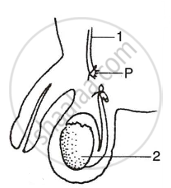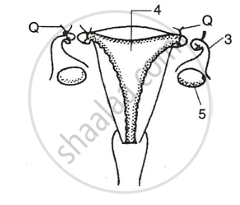Advertisements
Advertisements
प्रश्न
Observe the diagram A and B given below:

- Label parts 1 – 5.
- What does diagram A depict?
- What does diagram B depict?
- What comment on X and Y.
- State one function each of part 2 and 4.
उत्तर
- 1. Vas deferens
2. Testis
3. Oviduct
4. Uterus
5. Ovary - Diagram A depicts vasectomy in males (i.e., cutting and tying the vas deferens).
- Diagram B depicts tubectomy in females (i.e., cutting and typing the oviducts).
- ‘X’ represents the cut and tied end of vas deferens in male. Cutting and tying of vas deferens prevents the passage of sperms and avoids pregnancy. ‘Y’ represents the cut and tied ends of oviducts of female. Cutting and tying of oviducts prevents the passage of ovum and avoids pregnancy.
- Part 2 (Testis) produces sperms (male gametes).
Part 4 (Uterus) carries and protects the foetus till its birth.
APPEARS IN
संबंधित प्रश्न
Tubectomy is a popular surgical method of contraception in human males.
Name the Following: The cutting and ligation of vas deferens in males.
Which one of the following is an IUCD?
The embryo sac in a typical dicot at the time of fertilization is ______.
Give the biological term for the surgical method of contraception in human females.
Some vitamin preparations prevent the release of the egg from the ovary.
Write the full form of the following abbreviation:
IUDs
Given below is a set of paired terms. The first pair indicates the relationship between the two terms. Rewrite and complete the second pair on a similar basis.
Barrier method : Diaphragms :: Surgical method : ______.
Distinguish between the following pair:
Tubectomy and Vasectomy.
Observe the diagrams (A) and (B) given below and answer the following questions.
 |
 |
- Label the parts 1 to 5.
- What does figure A depict?
- What does figure B depict?
- Comment on P and Q.
- Mention one function each of part 2 and 4.
